When I first noticed how prevalent this style was, the most obvious thought was that, perhaps, a single large builder developed huge swaths of Chicago. But I have encountered dozens or hundreds of builder names. The O'Hare neighborhood, which I marveled at recently, makes a great case study, containing many homogeneous blocks. Consider, for example, this three-block stretch of Berwyn, lined with nigh-identical 2-flats:
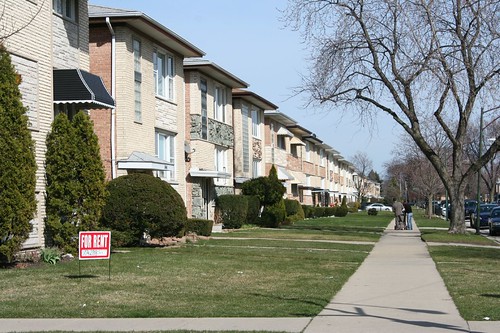
At a glance, these buildings are totally homegenous. They share identical massing, height, footprints, and unit layout (stairs on one side, two stacked units, giant picture windows.) Yet a careful look at their details shows that each builder did things a little bit differently, and had their own distinctive details that they used and re-used.
Take these buildings by the Relias Building Corporation, for example:
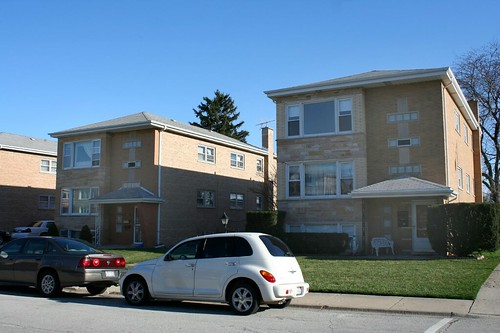
8359 and 8361 W. Berwyn Ave. The glass block design on the right is used on many Chicago MCM buildings.
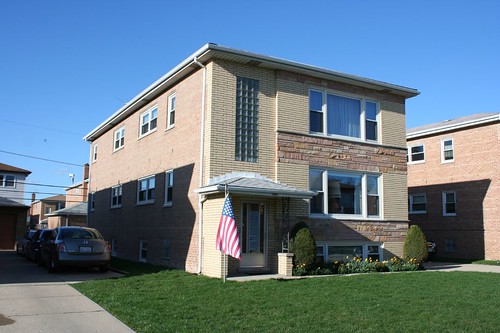
8356 W. Berwyn Ave
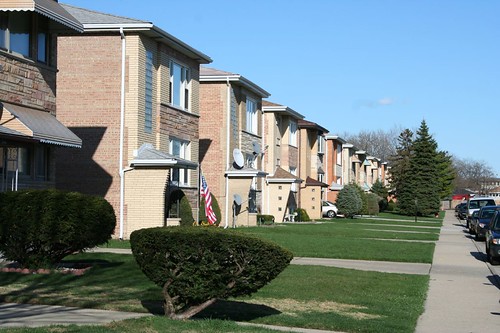
The 8300 block, north side. 8356 from the previous shot is at left. Notice the brick vestibule walls of each successive house - the first is the same as 8356, the next is a variation, and the next is a variation on the variation, and uses the same stairwell/glass block details as 8359 and 61 from the first shot. It's a good bet that Relias built this entire block.
But they sure didn't build the next two blocks!
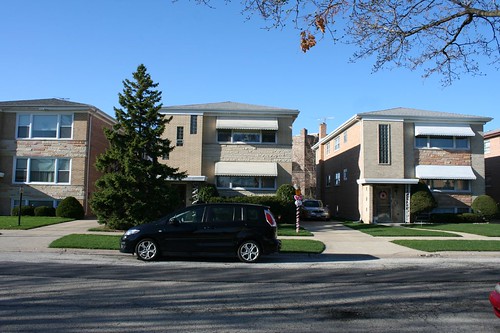
8426 W. Berwyn - Forest Lane Builders
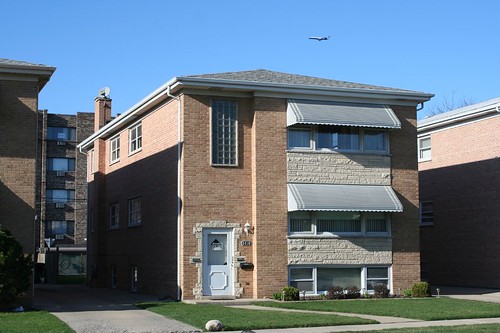
8410 W. Berwyn Avenue - Forest Lane Builders
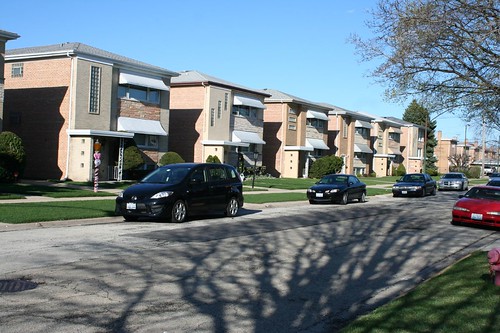
And here's what stands between the two Forest Lane buildings. The repeating porch wall design makes it almost certain that the three center buildings, and the ones at the far right, were by a single builder. Could it also be Forest Lane? Sure. One of them even re-uses the glass block design from the first Forest Lane building. A look at an aerial view on Google Maps reveals that every building shares the exact same curved sidewalk design, too, meaning the whole north side of the block is probably Forest Lane. But that wall detail... didn't we just see that a moment ago, on a building by Relias? Did Forest Lane build on the Relias block, or did one company just swipe a detail from the other?
Across the street, another company was busy. Below are two buildings by Frank J. Munao, a wealthy builder who also happened to be into horse racing. He was so prominent, in fact, that some hoods attempted to extort money from him in the early 1950s by threatening his wife and children. They wound up going to jail instead, and Mr. Munao went on to grace Berwyn Avenue with these 2-flats:
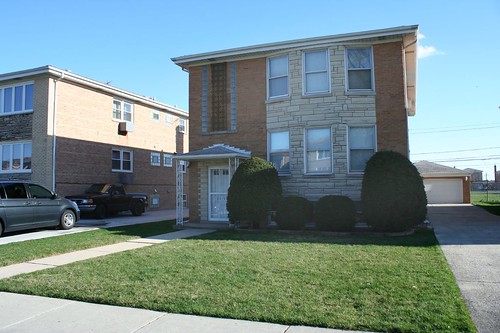
8455 W. Berwyn Avenue

8435 W. Berwyen Avenue
Given that distinctive concrete pattern block over the stairwell, it's a certainty that he also did these:
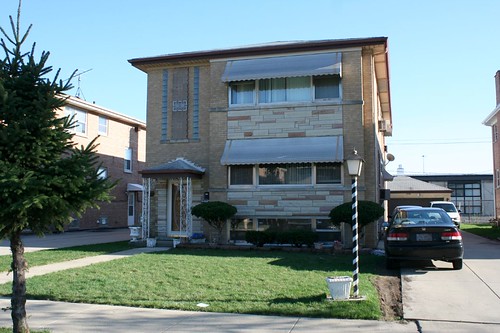
8423 W. Berwyn
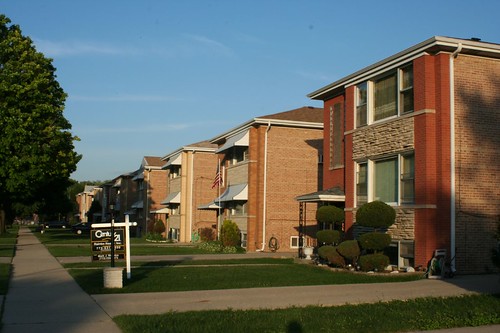
8439 W. Berwyn
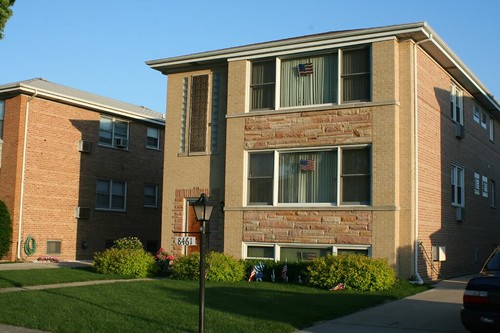
8461 W. Berwyn
And the same shape repeats here, minus the pattern block:
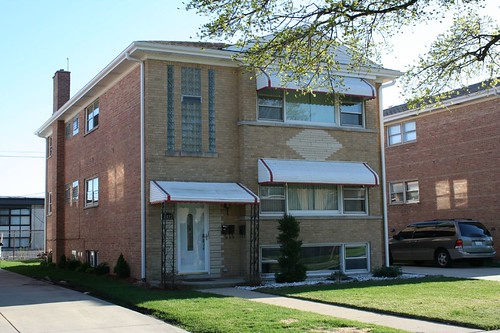
8427 W. Berwyn Avenue
So this whole side of the block is probably Frank J. Munao & Son, Inc.
One block west, and we're still in solid 2-flat territory, but with still more builders:
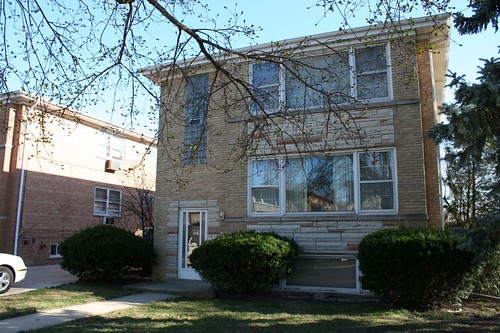
8555 W. Berwyn - C.O.R. Construction Co.
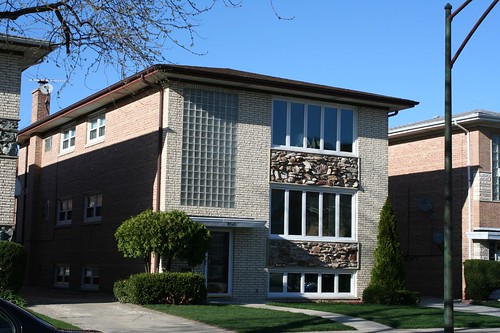
8540 W. Berwyn Avenue - Larry J. Pontarelli & Sons, Inc.
And so, in short, we've got three solid blocks of nothing but nigh-identical 3-flats.... by at least five different builders.
Further west on Berwyn, the 2-flats give way to 6-flats. Like the previous area, these buildings are rigorously aligned, and very similar in massing and style... but by a multitude of builders.
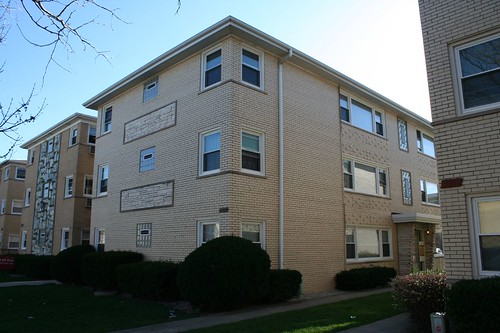
5222 N. Reserve Avenue - McNerney-Goslin, builder. They did a row of 5 or 6 buildings on this block.
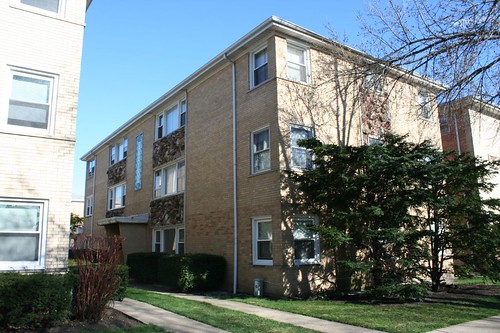
5231 N. Reserve Avenue - David J. Cahill
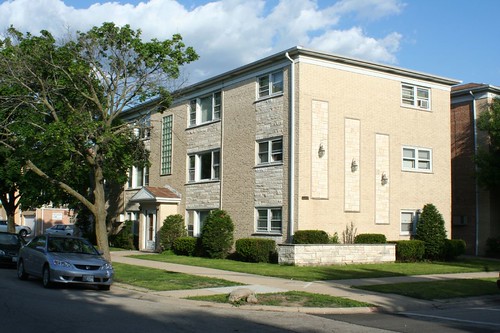
5241 N. Potawatomie Avenue - Relias Building Corp.
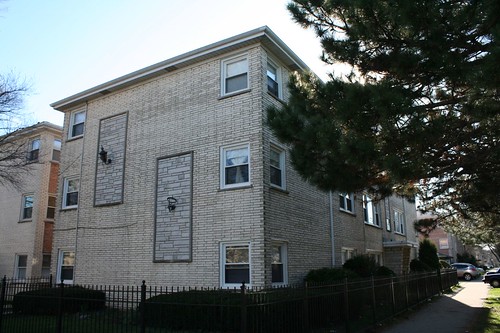
8639 W. Berwyn Avenue, SW corner of Berwyn and Potawatomie - aka 5240 N. Potawatomie. Ferlette Builders & Realty Co. Both this and the previous building (right across the street, and seeming to form a gateway with their prominent lamps) share New Formalist influences, but are by different builders. Clearly one of these buildings is reacting to the other.
Most of these 6-flats, spanning three parallel streets, align so perfectly that you can look through the gaps between them and see through corresponding gaps in two more blocks of identical buildings. And every decorative trick on these buildings shows up on other buildings by other builders. These different builders were clearly borrowing from each other and trying to work together.
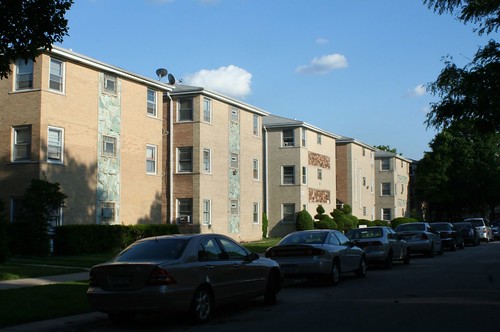
I have no solid explanation, though, for how this incredibly unified style came to be. As we've seen, a single builder was buying up a whole block, or large chunks of one, and stamping out the same designs. Zoning codes explain some of this homogeneity within neighborhoods, requiring similar dwelling unit types on blocks, setting setback limits and perhaps height restrictions as well. None of that, however, explains why a six-flat at 7600 N. Harlem Avenue (Parisi Brothers Construction Company) should look just like a 6-flat at 7724 W. Belmont Avenue (Nick S. Theodorau, architect) or one on 5200 N. Potawatomie.
The availability of affordable building materials is a likely factor - blonde brick, for example, was obviously cheap at the time. Brickmakers were experimenting with new cuts and colors at the time, as can be seen on many of these buildings. Many common components were catalog elements, such as the fancy doors and escutcheons and various kinds of glass block, and would have been readily available to any builder. Certain stone types that occur again and again were probably cheaply available as well, perhaps bought in bulk by local suppliers and sold to many contractors.
And then there was probably some good old fashioned peer pressure - all the cool kids are building modern-style apartments. Don'tcha wanna be cool? Builders are risk-adverse by nature; if they were building modern-clad buildings by the hundreds, it had to mean they were popular with the public. Certainly some of these elements were copped from famous designers of the day, and there was also a variety of cultural influences at work, too.
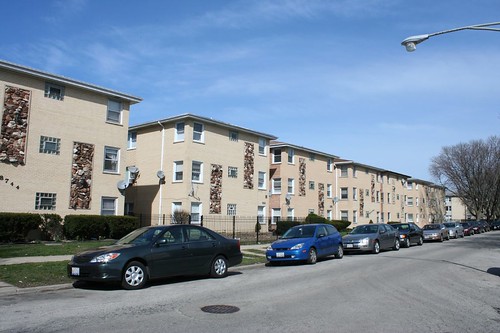
Despite all the explanations, it's still a remarkable convergence. These factors, and perhaps others still unknown, combined to produce a distinctive Chicago style that appears all over the region, and to my knowledge, nowhere else.
(For the record, most of the builder and architect data comes from a series of real estate advertisements run throughout the 1960s by the Peoples Gas Light and Coke Company, touting the merits of gas heating and appliances. Names of architects appear far less frequently than names of builders, but there is still plenty of variety.)
4 comments:
That's a fantastic photo essay. Have you had access to the trade magazines of the time period? That might be another current at work in these neighborhoods.
Look at the 3 story condo things going up around town since the mid-90s. You see a lot of them on Ashland north of Belmont, with face brick and balconies in the front, grey stone on the sides, and walk-up stoops in the front, usually with the house number stamped into the brick in front. shall we call those Chicago end-of century Quasi-Retro?
Have you looked at zoning ordinances and such? The "four-plus-one" blight of the 70's, which scarred neighborhoods which haven't recovered yet, was based on the loophole that a building up to 55 feet tall could be wood-framed.
In the other direction, half the apartment buildings between Wilson and Calvary Cemetery seem to have been built in 1926 or 1927, and you can find your way around those quarter million apartments blindfolded once you know the basic layout.
Thanks for the suggestions, all.
@L. Shure: I've had the idea, but I don't know what titles to look for or where to find access to them. Chicago's Realty and Building is the only one I've had much luck with, as it led me to the People's Gas ads.
@Petronius: Hah! I wonder if some building geek 50 years hence will be utterly fascinated with them.
@Neil: Zoning has certainly crossed my mind, though I've never looked into seeing what the codes said at the time. I'm not sure where to find that info, for one thing, and MCM buildings pop up in so many municipalities that it always seemed like an overwhelming endeavor to undertake.
Post a Comment